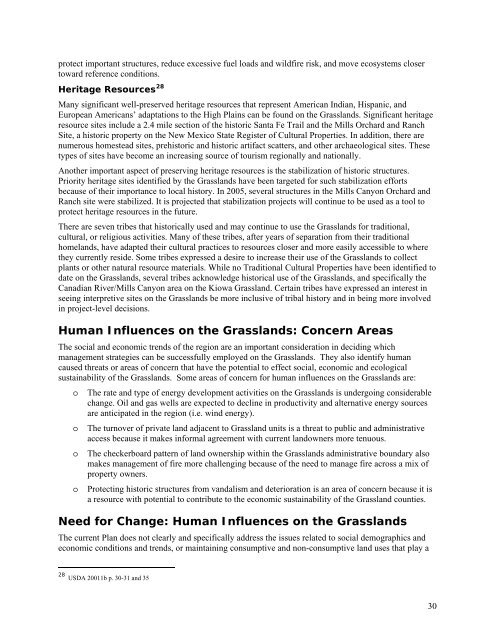Comprehensive Evaluation Report
Comprehensive Evaluation Report
Comprehensive Evaluation Report
You also want an ePaper? Increase the reach of your titles
YUMPU automatically turns print PDFs into web optimized ePapers that Google loves.
protect important structures, reduce excessive fuel loads and wildfire risk, and move ecosystems closer<br />
toward reference conditions.<br />
Heritage Resources 28<br />
Many significant well-preserved heritage resources that represent American Indian, Hispanic, and<br />
European Americans’ adaptations to the High Plains can be found on the Grasslands. Significant heritage<br />
resource sites include a 2.4 mile section of the historic Santa Fe Trail and the Mills Orchard and Ranch<br />
Site, a historic property on the New Mexico State Register of Cultural Properties. In addition, there are<br />
numerous homestead sites, prehistoric and historic artifact scatters, and other archaeological sites. These<br />
types of sites have become an increasing source of tourism regionally and nationally.<br />
Another important aspect of preserving heritage resources is the stabilization of historic structures.<br />
Priority heritage sites identified by the Grasslands have been targeted for such stabilization efforts<br />
because of their importance to local history. In 2005, several structures in the Mills Canyon Orchard and<br />
Ranch site were stabilized. It is projected that stabilization projects will continue to be used as a tool to<br />
protect heritage resources in the future.<br />
There are seven tribes that historically used and may continue to use the Grasslands for traditional,<br />
cultural, or religious activities. Many of these tribes, after years of separation from their traditional<br />
homelands, have adapted their cultural practices to resources closer and more easily accessible to where<br />
they currently reside. Some tribes expressed a desire to increase their use of the Grasslands to collect<br />
plants or other natural resource materials. While no Traditional Cultural Properties have been identified to<br />
date on the Grasslands, several tribes acknowledge historical use of the Grasslands, and specifically the<br />
Canadian River/Mills Canyon area on the Kiowa Grassland. Certain tribes have expressed an interest in<br />
seeing interpretive sites on the Grasslands be more inclusive of tribal history and in being more involved<br />
in project-level decisions.<br />
Human Influences on the Grasslands: Concern Areas<br />
The social and economic trends of the region are an important consideration in deciding which<br />
management strategies can be successfully employed on the Grasslands. They also identify human<br />
caused threats or areas of concern that have the potential to effect social, economic and ecological<br />
sustainability of the Grasslands. Some areas of concern for human influences on the Grasslands are:<br />
o The rate and type of energy development activities on the Grasslands is undergoing considerable<br />
change. Oil and gas wells are expected to decline in productivity and alternative energy sources<br />
are anticipated in the region (i.e. wind energy).<br />
o The turnover of private land adjacent to Grassland units is a threat to public and administrative<br />
access because it makes informal agreement with current landowners more tenuous.<br />
o The checkerboard pattern of land ownership within the Grasslands administrative boundary also<br />
makes management of fire more challenging because of the need to manage fire across a mix of<br />
property owners.<br />
o Protecting historic structures from vandalism and deterioration is an area of concern because it is<br />
a resource with potential to contribute to the economic sustainability of the Grassland counties.<br />
Need for Change: Human Influences on the Grasslands<br />
The current Plan does not clearly and specifically address the issues related to social demographics and<br />
economic conditions and trends, or maintaining consumptive and non-consumptive land uses that play a<br />
28 USDA 20011b p. 30-31 and 35<br />
30
















